An unpretentious variety that requires minimal care - the Japanese dwarf tomato
Experienced gardeners try to plant several varieties of tomatoes with different ripening periods on their site at once. This allows you to harvest tomatoes from late June to early October. There are usually no problems with the choice of mid-ripening and late-ripening varieties. Most of the fruits of such crops have excellent taste. With early ripe tomatoes, it is more difficult. Many of them have a mild flavor and are only suitable for greenhouse cultivation.
The Japanese dwarf tomato does not have the described disadvantages. This undersized variety grows even in extreme weather conditions, and its berries have a wonderful rich flavor. What are the nuances of growing this tomato - read on.
The content of the article
Description of the variety
The Japanese dwarf is a tomato variety that got its name from the short stature of the bush.... This tomato has nothing to do with Japan, as it was bred by Kazakhstani breeders.
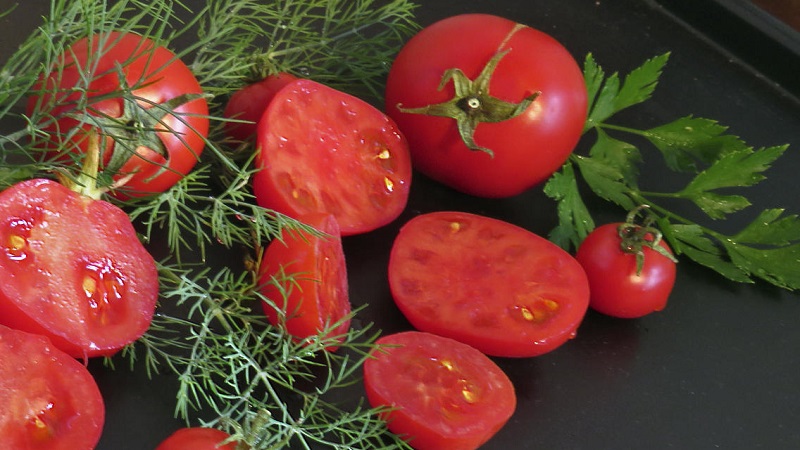
Despite the fact that this variety was bred a long time ago, it is difficult to find it on the Russian markets.... It is produced by Invest Plus. However, the plus is that the seeds of its fruits are used for the further cultivation of tomatoes, it is not necessary to buy them every year.
Note! The Japanese dwarf tomato is often confused with the Mongolian dwarf variety. These are different varieties with different characteristics.
Distinctive features of the Japanese dwarf
The main feature of the Japanese dwarf is the dwarfism of its bush. The plant reaches height only 30-55 cm.
The fruits of this variety are the most common. They are small and round... They have a red color and firm but tender flesh. Read more about the appearance of the fruit in the photo.
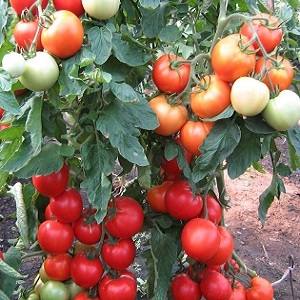 Taste for early ripe tomatoes the Japanese dwarf has a good one - rich, sweet with a slight sourness.
Taste for early ripe tomatoes the Japanese dwarf has a good one - rich, sweet with a slight sourness.
Another positive feature of this tomato is unpretentious care. It is resistant to temperature extremes and can grow in shaded areas. Thanks to this, its cultivation is possible in summer cottages.
Japanese dwarf together gives the harvest in the first half of summer... Thanks to this, he does not have time to get sick with late blight. Resistance to other diseases typical of nightshade crops is average in this variety.
During the fruiting period, the plants look very decorative.... The bushes take on a spherical shape and are covered with a large number of bright red fruits.
Read also:
What is good about the tomato "Raspberry empire"
General characteristics
Even novice gardeners can handle the cultivation of a Japanese dwarf... This is one of the most unpretentious varieties that will delight you with a good yield for early tomatoes, and an excellent fruit taste.
Characteristics and description of the variety:
| Parameter | Indicators |
| Bush type | Determinant, dwarf variety. Its height varies between 30-55 cm. The bushes are spreading, well leafy. The stems are not tall and strong and thick. The leaves are dark green, small in size, have the usual shape for tomatoes, no pubescence. The inflorescences are simple.The first is formed in the bosom of 5-6 leaves, the next through 1 sheet. Fruits are collected in clusters of 4-5 pcs. |
| Growing method | Tomatoes are resistant to temperature extremes and can grow even in shaded areas of the garden. The cultivation of tomatoes in the open field is mainly practiced. It is possible to plant tomatoes in pots and flowerpots. |
| Yield | Average. Up to 2 kg of tomatoes are harvested from one bush. For 1 sq. 5-9 plants are planted. Therefore, the harvest is good. |
| Fruit | Medium size. The mass of one berry reaches 50-70 g. The maximum weight of the fruit reaches 100 g. The shape is round, slightly flattened at the base. There is a slight ribbing at the base. The color of the berries is red inside and out. There is a light green spot at the base. The pulp is firm, but tender and juicy. The taste of tomatoes is sweet, with a slight pleasant sourness. Each fruit contains 4-5 chambers with a small amount of seeds. |
| Transportability | High. Smooth, thin but strong skin prevents the fruit from cracking. Tomatoes are stored for 3-4 weeks. |
| Ripening terms | Early ripe. Fruits ripen 85-95 days after seed germination, they are characterized by amicable ripening. |
| Disease resistance | Has an average immunity to tomato diseases. Does not have time to get sick with late blight. |
It is interesting! Gardeners' reviews indicate that the Japanese dwarf rarely gets sick.
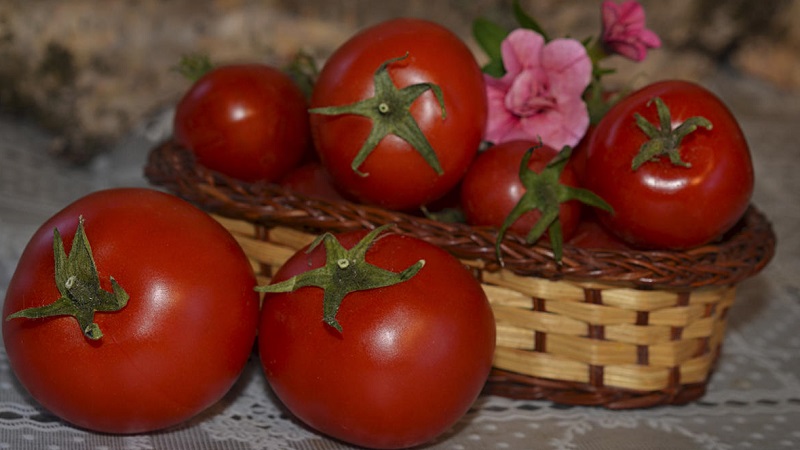
Growing seedlings
Seedlings of early ripe tomatoes begin to grow 50-60 days before planting in a permanent place. The Japanese dwarf is grown mainly outdoors.
The timing of sowing seeds for seedlings will differ for different regions.:
- southern - early March;
- central - the second half of March;
- northern - early April.
When growing tomatoes at home in pots, sowing dates seeds don't matter.
Seed preparation
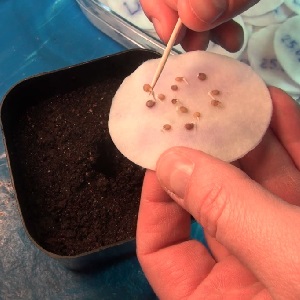 Most gardeners purchase Japanese Dwarf seeds from their hobby colleagues. Such planting material must be checked for germination... To do this, it is soaked for half an hour in a glass of water with the addition of 1 tsp of salt. Floated specimens are collected and discarded. The seeds that have sunk to the bottom are washed and used for planting.
Most gardeners purchase Japanese Dwarf seeds from their hobby colleagues. Such planting material must be checked for germination... To do this, it is soaked for half an hour in a glass of water with the addition of 1 tsp of salt. Floated specimens are collected and discarded. The seeds that have sunk to the bottom are washed and used for planting.
The planting material must be disinfected. To do this, it is soaked for 20 minutes in hydrogen peroxide or a light pink solution of potassium permanganate.
Another option is soaking in a growth promoter... Use "Sodium humate", "Epin" or "Zircon". As folk remedies that accelerate the germination of planting material, use water with honey, soda solution or aloe juice.
Compilation of soil mixture and selection of containers
For tomato seedlings, choose a light but nutritious soil.... Suitable formulations are sold in specialized stores, but most gardeners prefer to prepare the soil themselves.
There are many ways to prepare soil for tomatoes. The list contains several good options:
- Equal parts of black soil and peat are mixed. In the resulting composition add 0.5 part of humus and 1 hour of river sand. On a bucket of the resulting mixture, take 10 g of ammonium nitrate and potassium chloride.
- For 3 kg of peat, 1 kg of sawdust, 0.5 kg of mullein and 1.5 kg of river sand are taken. For this amount of soil mixture, take 5 g of ammonium nitrate and potassium chloride, as well as 10 g of superphosphate.
- Peat, humus, garden soil and sawdust are mixed in equal proportions. 1.5 tbsp of ash is taken on a bucket of mixture, 1 tbsp. l potassium sulfate, 3 tbsp. l superphosphate and 1 tsp urea.
The soil for tomatoes must be disinfected. To do this, it is calcined in the oven or watered with a dark pink solution of potassium permanganate.
For sowing seeds, take large, shallow containers... They use both special trays, cassettes and boxes, and improvised means.
For picking plants, use any deep containers with a volume of at least 300 ml. Drainage holes are made at the bottom of homemade pots.
All dishes for sowing seeds are disinfected - soaked in a dark pink solution of potassium permanganate.
Sowing seeds
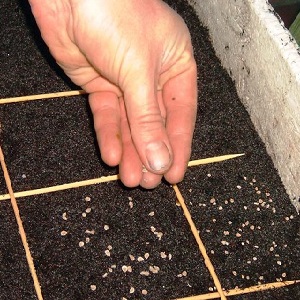 Japanese dwarf is an inexpensive and unpretentious variety... More often it is grown by sowing seeds in one large container and then picking them into individual pots.
Japanese dwarf is an inexpensive and unpretentious variety... More often it is grown by sowing seeds in one large container and then picking them into individual pots.
The soil is poured into the seedling box... The soil is abundantly watered and leveled. Grooves are made 1 cm deep at a distance of 2-3 cm from each other. Seeds are placed in them with an interval of 2 cm.
The seeds are covered with soil. The containers are covered with foil and put in a warm place with a temperature of 24-26 ºC.
Seedling care rules
Growing tomato seedlings is easy... You just need to follow the basic rules for caring for her:
- When the first shoots appear, the film is removed from the boxes. They are moved to a well-lit place. Experienced gardeners recommend that after seed germination, take the seedlings for a week in a room with a temperature of 17 ºC. The plants are then placed in a warm place. This will prevent premature pulling of the tomatoes.
- Sprinkle tomatoes with warm water. Water should not fall on the ground part of the plant. The frequency of watering depends on the rate of soil drying.
- When real (not cotyledonous) leaves appear, the tomatoes dive into separate pots. A drainage layer is poured into the bottom of the containers. You do not need to pinch the plant root.
- 3 times during the period of growing seedlings, it is fed. The first time is 2 weeks after picking into individual containers, the second time is 14 days after the previous feeding, the last time is 5 days before the tomatoes are planted in open ground. Complex fertilizers or biohumus are used.
- Tempering tomatoes will allow them to quickly adapt to outdoor conditions. For this, the seedlings are taken out daily for several hours. The procedure is started 2 weeks before the tomatoes are planted in a permanent place.
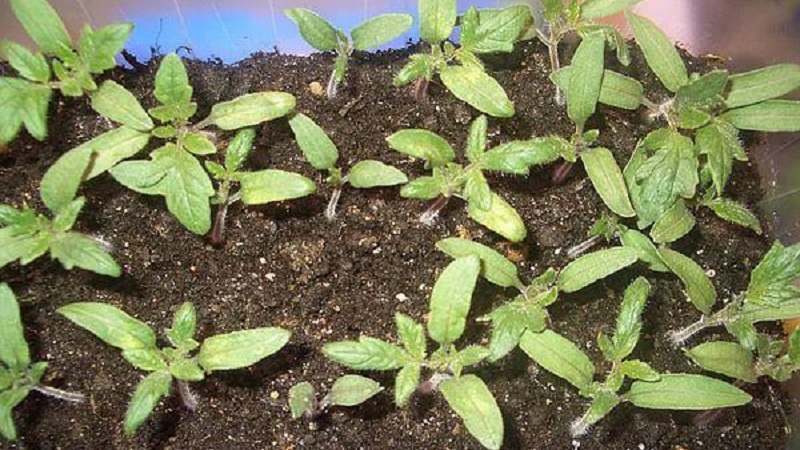
Agricultural technology of the Japanese dwarf
The Japanese dwarf is planted outdoors when soil temperature at a depth of 15 cm will reach 16 ºC. In the northern regions this occurs in early June, in the central regions - in mid-May, in the southern regions - at the end of April.
It is possible to grow the Japanese dwarf by seed method in the southern regions... In this case, the fruits will ripen much later. Planting material is sown in open ground in early May. After sowing the seeds, the beds are covered with foil.
About other varieties of tomatoes:
Unpretentious care and generous harvest tomato "Tea Rose"
Tomato "Aphrodite f1" loved by gardeners in all regions of the country
Planting seedlings in a permanent place
In the fall, you need to prepare tomato beds... They are dug up, cleaned of cultivated and weed plants. The soil is fertilized with mullein or humus. With increased acidity of the soil, dry lime is added to it.
In the spring, the tomato beds are dug up again... All formed plant roots are removed. The soil is treated with copper sulfate.
All tomatoes are light-loving plants. It is better for them to choose the most illuminated place in the garden. Tomato Japanese dwarf can grow in shaded areas.
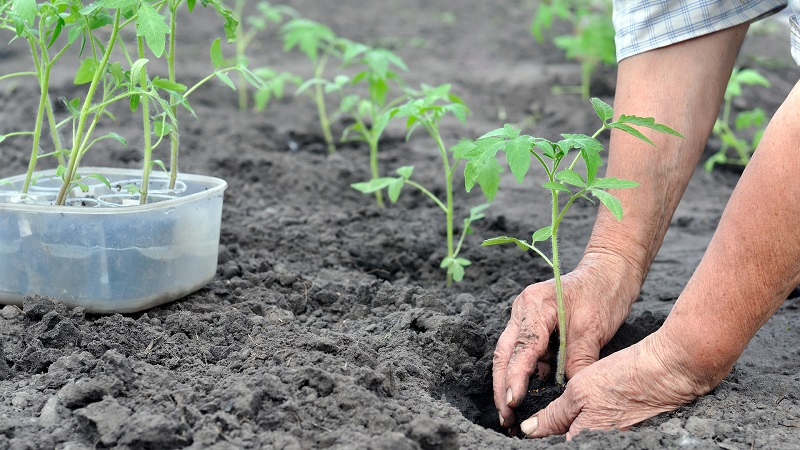
Holes for the Japanese dwarf are dug in rows in a checkerboard pattern... The optimal landing pattern is 50x50. In this case, 1 sq. m fits 5 plants. A thickened planting is also possible for this variety. For 1 sq. m, some gardeners place up to 9 plants. The yield in this case will be lower.
Pour 1 tbsp into the holes. l ash or granular fertilizers of long-term effect. A tomato is immersed there along with a clod of earth. The deepening is covered with earth, which is tamped.
Each tomato is watered with 1 liter of water... The next watering will be possible in two weeks.
Tomato care
Tomato Japanese dwarf is small... It doesn't need to be tied up.
The instructions say that it is not necessary to form bushes of this variety... Experienced gardeners are advised to remove unnecessary stepsons. Otherwise, the yield of the Japanese dwarf will decrease, and the fruits will be small.
Water the plants as the soil dries... One bush uses 1.5-2 liters of water.On average, 2 waterings are done per week. This variety also tolerates short droughts.
Foliar dressings are applied 2-3 times per season... Organic and mineral compositions alternate. Use means with boron in the composition. They accelerate the formation of ovaries.
The nuances of growing a Japanese dwarf
To get the maximum yield of the Japanese dwarf tomato, you need to know a few nuances of caring for him:
- The Japanese dwarf is a must-have. To do this, once for the entire period of its cultivation (when the first brush blooms), remove all stepsons below the upper flower brush. You also need to remove all unnecessary growth. The processes above the first hand are not removed.
- If the fruits of this variety lie on the ground, then to reduce the likelihood of disease, place cardboard or plywood under them.
- To speed up the formation of ovaries, periodically shake the tomato bushes.
- The beds of the Japanese dwarf must be weed regularly. The presence of weeds in the garden bed will negatively affect the condition of the tomato roots.
Diseases and pests
The Japanese dwarf is moderately resistant to tomato diseases... It must be protected from fungal and viral pathogens.
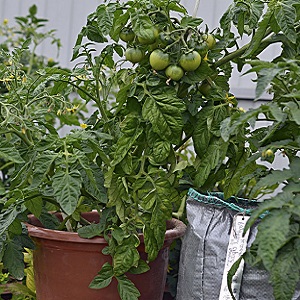 Methods for the prevention of tomato diseases:
Methods for the prevention of tomato diseases:
- Disinfect not only the soil, containers and planting material, but also garden tools.
- Regular weeding of beds and cleaning of plant debris will prevent tomato infestation - weeds carry spores of viruses and fungi.
- Regular but moderate watering and loosening of the soil. It is the waterlogged soil with poor air exchange that creates ideal conditions for the development and spread of infections.
- Spraying tomato bushes with a solution of potassium permanganate. This product, harmless to humans, will protect tomato bushes from fungal infection.
- Protection of bushes from insects. Plants are sprayed with soapy water or dandelion decoction. Large insects are collected from the bushes by hand.
Features of the cultivation of the Japanese dwarf at home and in the garden
Japanese midget is rarely planted in greenhouses... They are resistant to temperature extremes and can grow outdoors even in northern regions.
When growing tomatoes in the open field the first 2 weeks after the pick, in the evening they are covered with a film so that they do not die during night frosts.
Potted on the balcony the way of growing tomatoes is no different from their cultivation in the open field. Lack of lighting must be compensated for with fluorescent lamps.
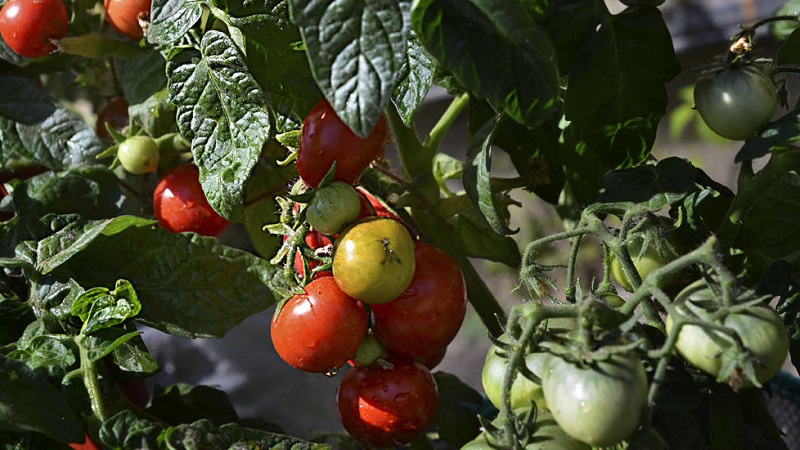
Harvesting and application of the crop
The first fruits of the Japanese dwarf are harvested at the end of June.... Ripe fruits are removed from the bush one by one together with the stalk.
Gastronomically, the variety is universal... Small sweet and sour tomatoes are good fresh, suitable for preserving whole and making tomato juice.
Advantages and disadvantages
Benefits of the Japanese dwarf:
- resistance to temperature extremes;
- the ability to grow in shaded areas of the garden;
- early maturity;
- unpretentious care;
- great fruit taste;
- good yield.
There were no drawbacks in this variety.
Farmers reviews
Reviews of the Japanese dwarf are good. This variety is loved by both beginners and experienced gardeners..
Galina, Yekaterinburg: “I have been growing a Japanese dwarf outdoors for 5 years. This is my favorite early maturing variety. Its small red fruits are delicious. I plant one bed, so we eat all the tomatoes fresh. Very easy to grow. You only need to step-son him once. I water it once a week. ".
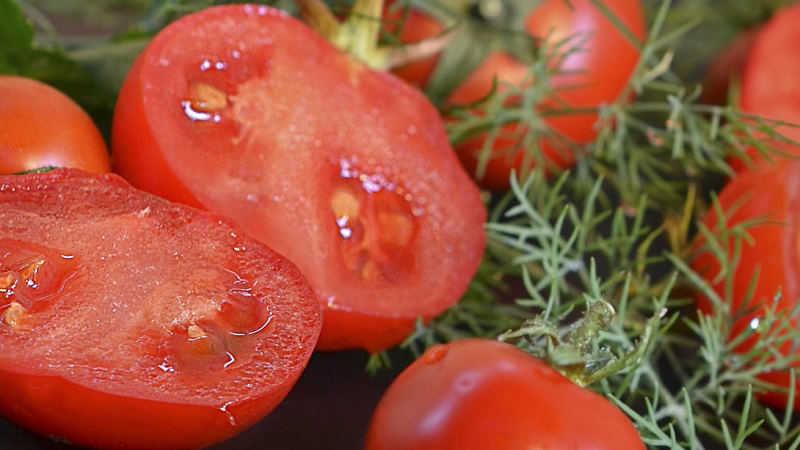
Irina, Kursk: “I borrowed the Japanese dwarf from a friend. I really wanted to try to grow an early ripe variety that requires minimal maintenance. The tomato met the expectations. I felt great at the dacha, which I visited once a week. The first tomatoes ripened at the end of June. I liked the taste. I will plant more! ".
Conclusion
The Japanese dwarf is an early ripe tomato that produces small fruits with a rich, pleasant taste.For varieties with similar ripening times, it has a good yield and decorative appearance.
Raising a Japanese dwarf is not difficult. It does not require a garter, is not afraid of temperature extremes and shading. All he needs is periodic watering and a one-time pinching.